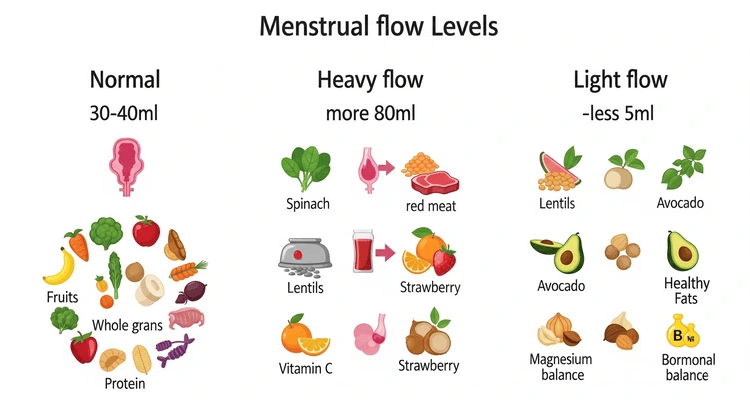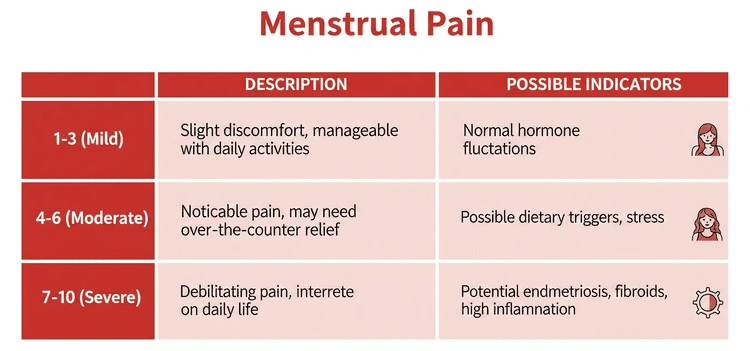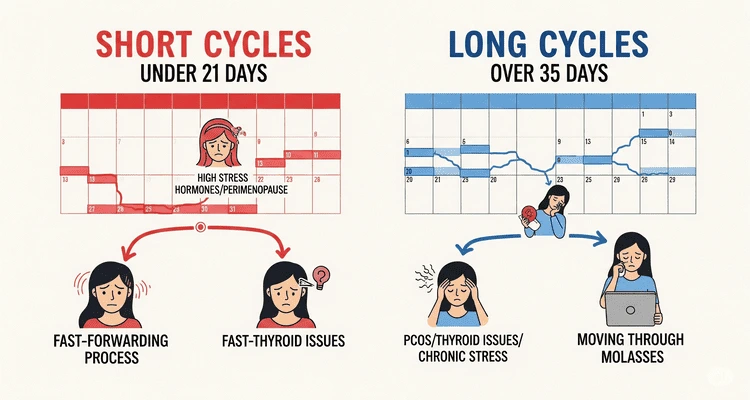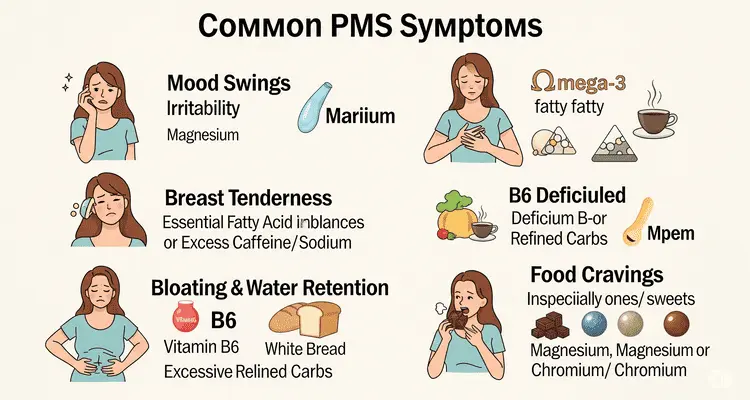Picture this: you’re sitting in your doctor’s office, and they ask about your last period. You mumble something vague about “last week maybe?” while secretly wondering why it even matters. Here’s the thing—your menstrual cycle is like your body’s monthly report card, packed with insights about your health that go way beyond just reproduction.
I’ve learned this the hard way. After years of dismissing irregular periods as “just stress,” I discovered my cycle was actually screaming important messages about my thyroid, iron levels, and overall wellness. Your period isn’t just an inconvenience—it’s a vital sign, as important as your blood pressure or heart rate.
So grab your favorite tea (or wine, no judgment here), and let’s decode what your body’s been trying to tell you every month. Trust me, this conversation will change how you view those few days that used to just annoy you.
1. Your Flow Reveals Your Iron and Nutrition Status
Ever wonder why you’re craving ice chips or feel like you could sleep for twelve hours straight during your period? Your menstrual flow might be the culprit, and it’s telling a bigger story about your nutritional health.
Heavy periods (soaking through a tampon or pad every hour for several consecutive hours) often signal iron deficiency anemia. When you’re losing significant blood monthly, your iron stores get depleted faster than a sale rack at Target. The result? Fatigue, brittle nails, restless legs, and that overwhelming urge to chew ice.
On the flip side, very light periods might indicate you’re not getting enough healthy fats or calories overall. Your body needs adequate nutrition to produce hormones, and when resources are scarce, period production gets put on the back burner.

Here’s what to watch for:
- Normal flow: 30-40ml total (about 2-3 tablespoons over your entire cycle)
- Heavy flow: More than 80ml or soaking through protection hourly
- Light flow: Less than 5ml or barely needing protection
The fix often lies in your kitchen. Iron-rich foods like spinach, lean meats, and beans can help heavy bleeders, while those with light periods might need more healthy fats from avocados, nuts, and olive oil. Sometimes, though, cutting out hidden sugars can dramatically improve hormonal balance and flow normalization.
2. Period Pain Intensity Points to Inflammation Levels
Let’s talk about that elephant in the room—period pain. While some discomfort is normal (thanks, evolutionary biology), debilitating pain that keeps you bedridden isn’t something you should just “tough out.”
Severe menstrual cramps often indicate high inflammation in your body. This isn’t just about your uterus throwing a monthly tantrum; it’s a sign that your entire system might be dealing with inflammatory stress from diet, lifestyle, or underlying conditions.
Mild cramping typically means your prostaglandins (hormone-like compounds that cause uterine contractions) are at normal levels. Severe pain suggests either excessive prostaglandin production or conditions like endometriosis or fibroids that amplify inflammation.

Anti-inflammatory foods like turmeric, ginger, and omega-3 rich fish can work wonders here. I’ve seen women completely transform their periods by ditching processed foods and adding more colorful vegetables to their plates. It’s not magic—it’s just giving your body the tools it needs to manage inflammation naturally.
3. Cycle Length Speaks Volumes About Hormone Balance
Your menstrual cycle length is like a window into your hormonal orchestra. When everything’s in harmony, you get that sweet 28-32 day rhythm. When hormones are out of whack? Well, that’s when things get interesting.
Short cycles (less than 21 days) often indicate high stress hormones or perimenopause. Your body’s basically fast-forwarding through the monthly process, which isn’t sustainable long-term.
Long cycles (more than 35 days) frequently point to PCOS, thyroid issues, or chronic stress. It’s like your reproductive system is moving through molasses, struggling to complete its monthly tasks.
According to the Northwestern Medicine health experts, tracking your cycle length over several months gives you valuable insight into your overall hormonal health. Consistency matters more than perfection—if you’re regularly 35 days, that might be normal for you.

The beauty of cycle tracking isn’t just about predicting when you’ll need tampons. It’s about understanding your body’s patterns and catching potential issues early. Apps make this easier than ever, but good old-fashioned calendar marking works just fine too.
4. Irregular Periods Highlight Stress and Lifestyle Impact
Here’s something most doctors don’t tell you: your period is essentially a monthly stress test. When life gets overwhelming, your menstrual cycle often reflects that chaos with irregular timing, missed periods, or unpredictable symptoms.
Chronic stress elevates cortisol, which directly interferes with reproductive hormones. It’s your body’s way of saying, “We’re in survival mode—now’s not the time for baby-making.” Smart system, inconvenient timing.
I’ve witnessed this personally during major life transitions. Moving cities, changing jobs, or relationship stress can throw off even the most regular cycles. The key is recognizing these patterns and addressing the root cause rather than just managing symptoms.
Common stress-related period changes:
- Periods arriving early or late unpredictably
- Skipping months entirely
- Heavier or lighter flow than normal
- Increased PMS symptoms
- Longer or shorter cycles
The solution often involves lifestyle adjustments: better sleep hygiene, stress management techniques, regular exercise (but not too intense), and adequate nutrition. Sometimes it’s as simple as saying no to that extra commitment or finally addressing that toxic relationship.
5. PMS Symptoms Reveal Nutrient Deficiencies
Before you write off PMS as “just part of being a woman,” consider this: severe premenstrual symptoms often indicate specific nutrient deficiencies that are totally fixable with the right approach.
Mood swings and irritability frequently link to magnesium deficiency. This mighty mineral helps regulate neurotransmitters, and when you’re low, emotions can feel like a runaway train.
Breast tenderness often points to essential fatty acid imbalances or too much caffeine and sodium in your diet.
Bloating and water retention might indicate B6 deficiency or excessive refined carbohydrate intake.
Food cravings, especially for chocolate or sweets, could signal magnesium or chromium deficiencies, not just lack of willpower.

The fascinating part? Many women find their PMS dramatically improves when they address these nutritional gaps. It’s not about perfection—it’s about giving your body what it needs to function optimally during hormonal fluctuations.
6. Period Color and Texture Tell Hormonal Stories
I know talking about period blood isn’t exactly cocktail party conversation, but stick with me here—the color and texture of your flow contains valuable health information that’s worth paying attention to.
Bright red blood typically indicates a healthy, fresh flow with good circulation and adequate estrogen levels.
Dark brown or black blood at the beginning or end of your period is usually old blood that’s been sitting in your uterus—totally normal and not concerning.
Pink or very light flow might suggest low estrogen levels, which could be related to excessive exercise, low body weight, or perimenopause.
Heavy clotting (clots larger than a quarter) can indicate hormonal imbalances, particularly elevated estrogen relative to progesterone.
Table: Period Colors and What They Mean
| Color | Typical Meaning | When to Consider Action |
|---|---|---|
| Bright red | Fresh, healthy flow | None needed if flow is normal |
| Dark red/brown | Older blood, normal at cycle start/end | If entire cycle is this color |
| Pink | Light flow, possible low estrogen | If consistently light for months |
| Gray | Possible infection | See healthcare provider immediately |
The texture matters too. Healthy menstrual blood flows smoothly with occasional small clots. Consistently heavy clotting or an unusual odor warrants a conversation with your healthcare provider.
7. Missing Periods Signal Serious Health Changes
When your period disappears for months (and you’re not pregnant or breastfeeding), your body’s sending a pretty clear message that something needs attention. This isn’t just about fertility—missing periods can indicate several underlying health issues.
Hypothalamic amenorrhea often results from excessive exercise, restrictive eating, or chronic stress. Your hypothalamus essentially shuts down reproductive function to conserve energy for survival.
PCOS frequently causes irregular or absent periods due to hormonal imbalances and insulin resistance.
Thyroid disorders can completely disrupt menstrual cycles, causing periods to become irregular or disappear entirely.
Rapid weight changes, whether loss or gain, can throw off the delicate hormonal balance needed for regular menstruation.
The concerning part isn’t just the missing periods—it’s what this means for your long-term health. Without regular ovulation and adequate hormone production, you’re at increased risk for bone density loss, cardiovascular issues, and other health complications.
Frequently Asked Questions About Period Health
Q: How long should a normal period last? A typical period lasts 3-7 days. Anything consistently shorter than 2 days or longer than 8 days might indicate hormonal imbalances worth investigating.
Q: Is it normal for periods to change as I age? Absolutely. Your cycles naturally evolve throughout your reproductive years. Perimenopause typically begins in your 40s and can cause significant changes in flow, timing, and symptoms.
Q: Should I track my period if it’s regular? Yes! Even regular cycles can provide valuable health insights. Plus, you’ll quickly notice any changes that might indicate health shifts.
Q: When should I see a doctor about my period? Consult a healthcare provider if you experience periods lasting longer than 7 days, cycles shorter than 21 days or longer than 35 days, severe pain that interferes with daily activities, or any sudden changes in your normal pattern.
Taking Action: Your Period Health Checklist
Understanding what your period says about your health is just the first step. Here’s your practical action plan:
Start tracking immediately. Whether you use an app or a simple calendar, begin noting cycle length, flow intensity, symptoms, and any patterns you observe.
Assess your nutrition. Focus on iron-rich foods if you have heavy periods, anti-inflammatory options if you experience severe cramping, and adequate healthy fats for hormone production.
Manage stress proactively. Your period will thank you for consistent sleep, regular moderate exercise, and stress-reduction techniques that actually work for your lifestyle.
Don’t ignore concerning symptoms. Severe pain, very heavy bleeding, or significant cycle changes deserve professional attention, not just “toughing it out.”
Consider the bigger picture. Your menstrual cycle doesn’t exist in isolation—it’s connected to your overall health, including nutrition, stress levels, exercise habits, and underlying medical conditions.
Your Monthly Health Report Card
Your period isn’t just a monthly inconvenience—it’s your body’s sophisticated way of communicating about your overall health. From revealing nutritional deficiencies to highlighting stress levels, your menstrual cycle provides insights that can guide better health decisions.
The most empowering part? Many period-related issues are completely manageable with the right lifestyle adjustments. You don’t have to suffer through debilitating cramps or unpredictable cycles just because you’re a woman.
Start paying attention to what your body’s telling you each month. Track patterns, notice changes, and don’t hesitate to seek professional guidance when something doesn’t feel right. Your future self will thank you for taking these monthly messages seriously.
Remember, knowledge is power—especially when it comes to understanding your own body. Your period has been trying to tell you important things about your health all along. Now you finally know how to listen.
Ready to dive deeper into optimizing your health? Check out our comprehensive guides on nutrition, stress management, and hormonal balance to support your overall well-being.



I have recently started a web site, the information you offer on this site has helped me greatly. Thank you for all of your time & work.
I am impressed with this web site, real I am a big fan .
Thank you so much for giving everyone an extraordinarily nice opportunity to check tips from this site. It can be very ideal and packed with fun for me personally and my office peers to visit your web site really thrice every week to see the new guides you have. And of course, I am at all times astounded considering the mind-boggling methods you give. Some 4 tips in this post are completely the best I’ve ever had.